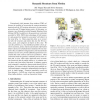173
Voted
CVPR
2011
IEEE
14 years 4 months ago
2011
IEEE
The Perspective-Three-Point (P3P) problem aims at determining the position and orientation of the camera in the world reference frame from three 2D-3D point correspondences. This ...
138
click to vote
TSMC
2010
14 years 7 months ago
2010
Most existing camera placement algorithms focus on coverage and/or visibility analysis, which ensures that the object of interest is visible in the camera's field of view (FOV...
263
Voted
NAR
2011
14 years 7 months ago
2011
The Community Cyberinfrastructure for Advanced Microbial Ecology Research and Analysis (CAMERA, http://camera.calit2.net/) is a database and associated computational infrastructur...
152
Voted
IJCV
2011
14 years 7 months ago
2011
Linear or 1D cameras are used in several areas such as industrial inspection and satellite imagery. Since 1D cameras consist of a linear sensor, a motion (usually perpendicular to ...
141
click to vote
CVPR
2011
IEEE
14 years 9 months ago
2011
IEEE
This paper addresses the problem of 3D motion reconstruction from a series of 2D projections under low reconstructibility. Reconstructibility defines the accuracy of a 3D reconst...
159
click to vote
CVPR
2011
IEEE
14 years 9 months ago
2011
IEEE
We describe an imaging architecture for compressive video sensing termed programmable pixel compressive camera (P2C2). P2C2 allows us to capture fast phenomena at frame rates high...
164
click to vote
CVPR
2011
IEEE
14 years 9 months ago
2011
IEEE
Conventional rigid structure from motion (SFM) addresses the problem of recovering the camera parameters (motion) and the 3D locations (structure) of scene points, given observed ...
132
Voted
CVIU
2010
14 years 9 months ago
2010
Most of the existing panoramic cameras have cylindrical field of view (FOV) which has a 360
153
Voted
CVPR
2011
IEEE
14 years 9 months ago
2011
IEEE
We present a simple, accurate, and flexible method to calibrate intrinsic parameters of a camera together with (possibly significant) lens distortion. This new method can work u...
126
Voted
ICMCS
2009
IEEE
14 years 10 months ago
2009
IEEE
Augmented Virtual Environments(AVE) are very effective in the application of surveillance, in which multiple video streams are projected onto a 3D urban model for better visualiza...




